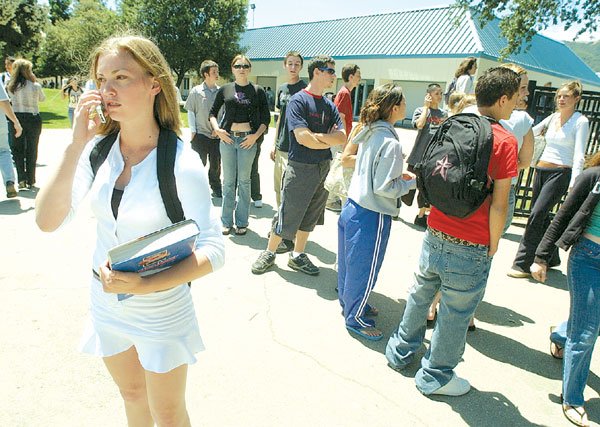GILROY
– Depending on who was asked Friday morning, there was a student
holding a teacher hostage, at gunpoint, inside a classroom.
Or, someone planted a bomb on campus and police were combing the
grounds for it.
GILROY – Depending on who was asked Friday morning, there was a student holding a teacher hostage, at gunpoint, inside a classroom.
Or, someone planted a bomb on campus and police were combing the grounds for it.
Or, a sniper on the roof of the school was preparing to shoot any student or teacher who exited the classroom.
And on and on it went Friday morning after a student called a 9-1-1 dispatcher and threatened to shoot a teacher.
Cell phones, a communication staple in this technological age, did exactly what they were designed to do last week: They made it easy to disseminate information to many, as soon as it became available.
However, much of that information was false.
The tales circulating during a three-hour lockdown at Gilroy High School Friday morning proved to both help and hurt the situation, particularly for parents and students. While cell phones and pagers made it easy and quick to find out how loved ones were doing, they also helped stories spread like wildfire, filling the information void with rumors and speculation.
Standing across the street from the campus on 10th Street, Dena Gonzales held a cell phone and waited for more news from her sister, Amanda, a freshman. Gonzales received a text message from her sister, who was inside a GHS classroom, just after 9:30 a.m.
“One of the text messages said that the school is on lockdown. She said it was not a drill, so I came,” Gonzales said.
During the next 20 minutes, Amanda Gonzales told her sister at least three different stories she heard from various students who called or sent text messages to her from other classrooms.
“I told her not to really believe what she hears because it’s going from cell phone to cell phone, and it’s just rumors,” Dena Gonzales said.
Marisa Fowler, a junior at GHS, said students “were believing everything we heard, from a bomb threat to a hostage crisis to mini-riots.”
“I think so many rumors started because the police and the administration didn’t communicate with parents and students,” said Mikele Fowler, Marisa’s mother. “It’s not like she’s a little kid. She expects to be told something.”
Gilroy police stressed the importance of heading off rumors by providing truthful information.
“If we don’t release information to students and parents, they’re going to fill in the gaps with inaccurate information,” Assistant Police Chief Lanny Brown said moments before the school lockdown ended.
Brown was right.
Emotional students and frantic parents communicating via cell phone and text messaging heard at least one of several false rumors and even doubted police when officers reported the little, but accurate, information they had.
School officials agreed that swirling rumors are the last thing they want in a crisis situation. However, the first priority in such a lockdown is ensuring student safety, so communication often must come afterward, said Roger Cornia, the district’s student safety officer.
“We worry more about getting the information out after the lockdown,” he said.
Partly due to the proliferation of rumors and the throngs of worried parents lining streets around the high school, Gilroy Unified School District officials used Glen View Elementary School, at Princevalle and Eighth streets, as a de-briefing point. There, district and school administrators assured groups of parents that any and every rumor they were hearing was false.
“There’s no truth to a bomb on campus. There’s no truth that a teacher is being held hostage,” Assistant Superintendent Linda Piceno told parents. “No weapons have been found. No one has been taken off in handcuffs.”
Nevertheless, no additional information about what prompted the lockdown was provided. Parents leaving the meeting said they still did not understand why the lockdown was happening, particularly if none of the rumors were true.
Still, hearing that the rumors were just that – rumors – let several parents rest a little easier until the lockdown ended.
“They gave me not a lot of information, but enough to put me at ease and make sure everyone is safe,” said Rosanne Struthers, whose son and daughter attend GHS. “I’m just happy that (my children) had their cell phones on them because I could not get an answer at the school.”
Carlene Aldridge kept in constant touch with her two daughters – Shanna, a senior, and Kayla, a junior – to glean what little news she could. A text message from one daughter to another moved their mother almost to tears.
“We can get through this together,” it read.
Before the meeting, Aldridge said, she was nearly worried sick: One daughter described the scene in a classroom where students were huddled under desks.
“I was pretty concerned, but after talking to them, I wasn’t,” she said. “I was more worried before I heard something.”
Many parents took comfort in hearing from their children that they were OK in spite of scant reliable information directly from the school. Others, without cell phones, had only rumors as their information source.
“I’m disappointed with the total system. I have a disabled child who can’t speak for himself and can’t walk or run. I wanted to be called (and told more information),” said Leonard Osana, the father of a special needs student. “Once I found out about this, I jumped up and got here right away.”
Staff Writer Eric Leins contributed to this report.
Lori Stuenkel covers education for The Dispatch. She can be reached at 842-6400 x277 or ls*******@************ch.com.













